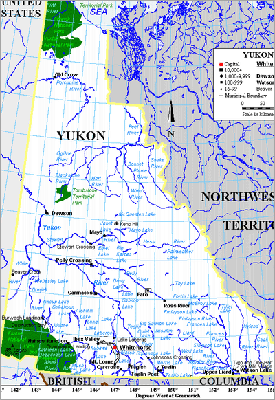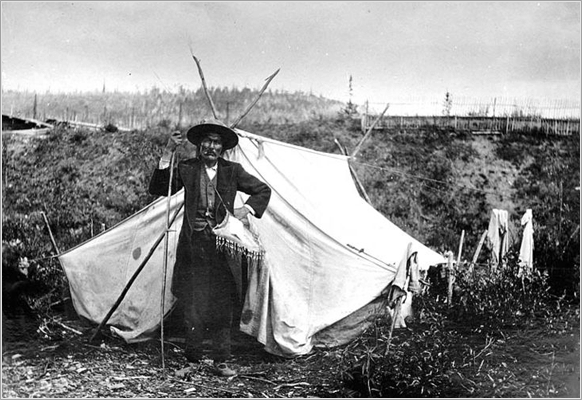Living in Canada:
Yukon
Overview
 Large map of the Yukon
Large map of the Yukon
Yukon, also known as The Yukon Territory, is one of Canada's three territories, in the country's far northwest. It has a population of about 33,897 and its capital is Whitehorse, with a population of 23,276. People from the Yukon are known as Yukoners.
The territory is named after the Yukon River, which means "great river" in Gwich'in.
Of Canada's 13 provinces and territories, the Yukon is the only one which is not further subdivided into census divisions such as counties - instead, the whole territory constitutes a single census division.
The territory's historical major industry is mining, including lead, zinc, silver, gold, asbestos and copper. Indeed, the territory owes its existence to the famous Klondike Gold Rush of the 1890s. Having acquired the land from the Hudson's Bay Company in 1870, the Canadian government divided the territory off of the Northwest Territories in 1898 to fill the need for local government created by the influx of prospectors during the Klondike Gold Rush.
Thousands of these prospectors, led by the chance at gold, flooded the area, creating a colourful period recorded by authors such as Robert W. Service and Jack London. (See also Royal Canadian Mounted Police.)
| Ethnic origins | |
|---|---|
| Ethnic origin | Percent |
| English | 28.5% |
| Scottish | 25% |
| Irish | 22% |
| First Nations | 21.8% |
| Canadian | 21.8% |
| German | 15.6% |
Immigration Profile
Yukon residents have been working in the resource industry for over a century. From forestry to mining exploration, generations of families have handed down their knowledge from generation to generation, helping to preserve a tradition of quality workmanship and Yukon residents have the ability to adapt to a changing world.
The Yukon is home to many cultures whose unique customs and traditions give the North the cultural diversity which is part of its charm. First Nations people account for a full quarter of the population, which also has a dynamic French-speaking population.
The territories are home to approximately 3,755 Canadian immigrants, according to the Canada 2011 Census.
The largest proportion of people that immigrate to Canada and settle in the territories came from the United Kingdom, the United States of America, Germany, and the Philippines.
Economy
The memory of this period, as well as the territory's scenic wonders and outdoor recreation opportunities, makes tourism the second most important industry.
Manufacturing, including furniture, clothing, and handicrafts, follows in importance, along with hydroelectricity. The traditional industries of trapping and fishing have declined.
Today, the government sector is by far the biggest employer in the territory, directly employing approximately 5,000 out of a labour force of 12,500.
Transportation
In the past, the major transportation artery was the Yukon River system, both before the Gold Rush and after. As well, the coastal Tlingit people traded with the Athabascan people using passes through the coastal mountains. See also Chilkoot Pass, Dalton Trail.
From the Gold Rush until the 1950s, riverboats plied the Yukon River, most between Whitehorse at the head of navigation and Dawson City, but some going further into Alaska and down to the Bering Sea, and others along tributaries of Yukon River such as the Stewart River.
Most of the riverboats were owned by the British-Yukon Navigation co, an arm of the White Pass and Yukon Route, which also operated a narrow-gauge railway from Skagway, Alaska to Whitehorse. The railway ceased operation in the 1980s with the first closure of the Faro mine. It is now operated as a summer time tourist train, with operations running as far north as Carcross.
Today, major land transportation routes include the Alaska Highway, which passes through Whitehorse; the Klondike Highway going from tidewater in Skagway, Alaska through Whitehorse to Dawson City; the Haines Highway from Haines, Alaska to Haines Junction, Yukon, and the Dempster Highway from the Klondike Highway to Inuvik, Northwest Territories. All these highways, except for the Dempster, are paved. Other highways with less traffic include the Campbell Highway which goes from Carmacks on the Klondike Highway, through Faro and Ross River, and veers south to join the Alaska Highway in Watson Lake, and the Silver Trail which forks off the Klondike Highway at the Stewart River bridge to connect the old silver mining communities of Mayo, Elsa and Keno City. All Yukon communities except one are accessible by mostly paved roads, but air travel is the only way to reach one remote community in the Far North (Old Crow).
Whitehorse International Airport serves as the air transport infrastructure hub, with direct flights to Vancouver, Calgary, Edmonton, Fairbanks, Juneau and Frankfurt (summer months). Every community is served by an airport, and an air charter industry exists primarily to serve the tourism and mining exploration industries.
Government
 Chief Isaac of the Han, Yukon Territory, ca. 1898
Chief Isaac of the Han, Yukon Territory, ca. 1898
The Yukon Act, passed on April 1, 2003, formalised the powers of the Yukon government and devolved a number of additional powers to the territorial government (e.g., control over land and natural resources).
At the federal level, the territory is presently represented in the Parliament of Canada by a single Member of Parliament and one senator. In contrast to United States territories, Canadian territories' members of Parliament are full and equal voting representatives and residents of the territory enjoy the same rights as other Canadian citizens. One Yukon Member of Parliament - Erik Nielsen - was the Deputy Prime Minister under the Mulroney government, while another - Audrey McLaughlin - was the leader of the federal New Democratic Party.
Yukon was one of nine jurisdictions in Canada to offer same-sex marriage before the passage of Canada's Civil Marriage Act, along with Ontario, British Columbia, Quebec, Manitoba, Nova Scotia, Saskatchewan, Newfoundland and Labrador, and New Brunswick. See same-sex marriage in Yukon.
First Nations Governments
Much of the population of the territory is First Nations. An umbrella land claim agreement representing 7,000 members of fourteen different First Nations was signed with the federal government in 1992. Each of the individual First Nations then has to negotiate a specific land claim and a self-government agreement.